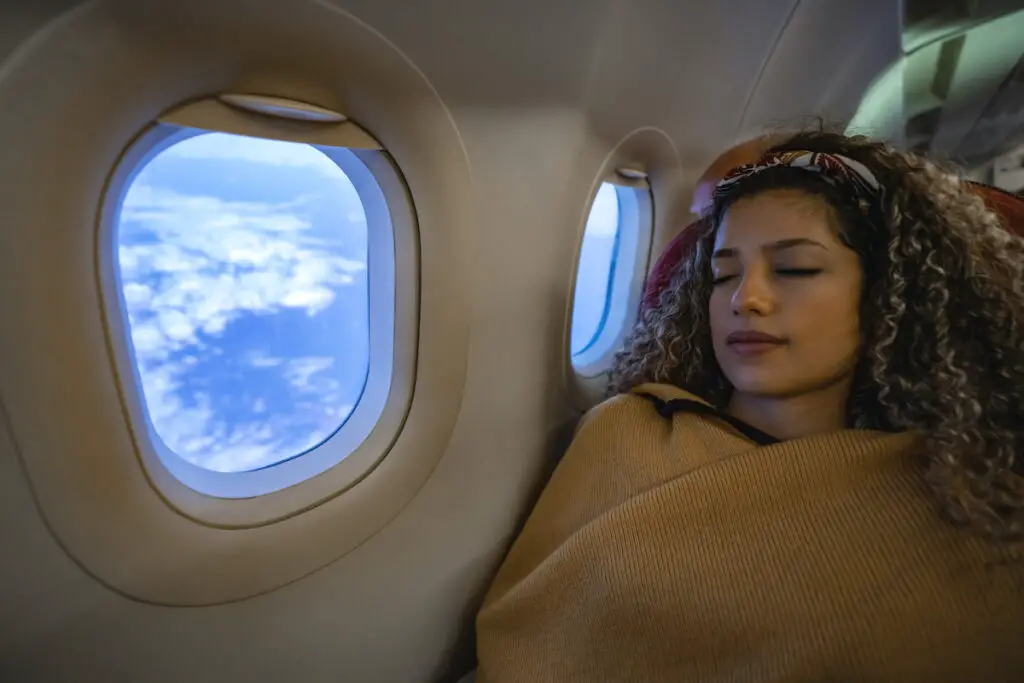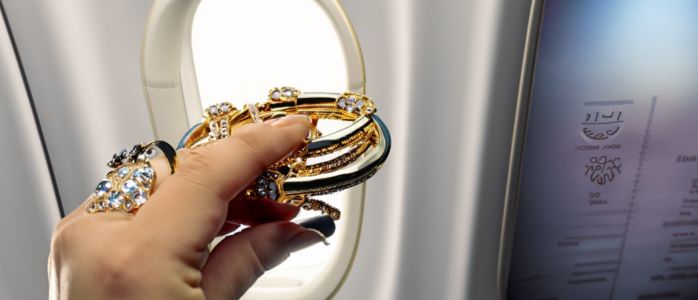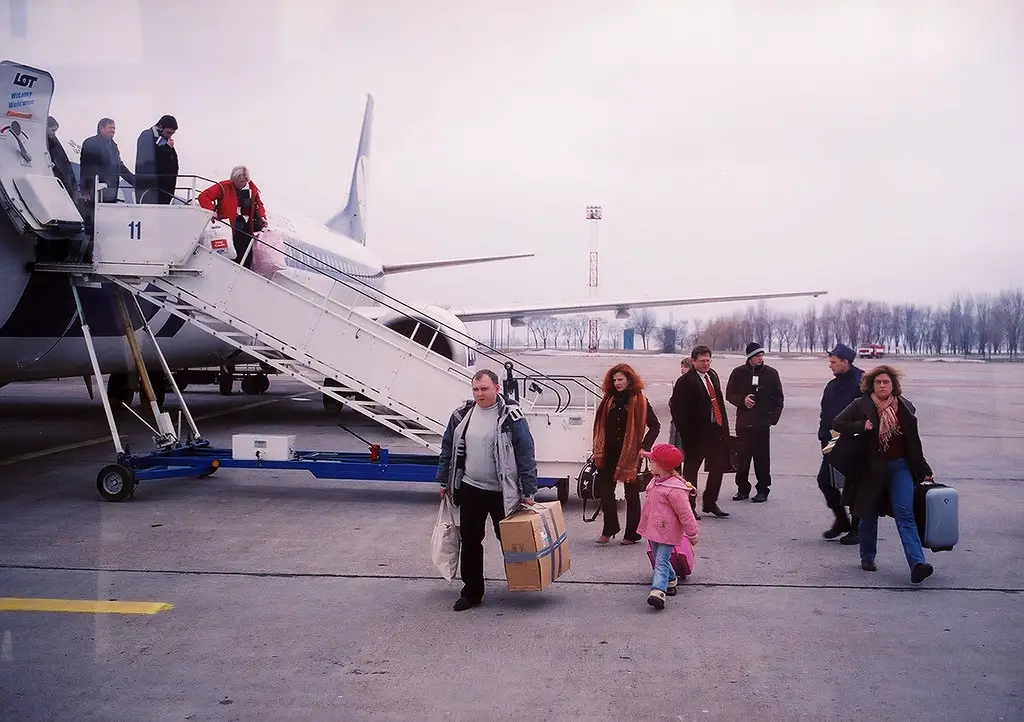Embarking on a journey by air entails not only excitement about the upcoming destination but also strategic planning, especially when it comes to your travel attire.
The choice of clothing for a plane journey goes beyond mere fashion preferences; it’s about striking the right balance between comfort, practicality, and style.
As you prepare to soar through the clouds and navigate airport terminals, the question arises: What to wear for traveling on a plane? This seemingly simple query opens up a realm of considerations, from the length of the flight to the potential temperature variations within airports and airplanes.
Let’s delve into the art of selecting the perfect ensemble for a seamless and enjoyable airborne experience.
1. Comfortable Basics
Breathable Fabrics:
When it comes to choosing the ideal attire for air travel, the significance of breathable fabrics cannot be overstated.
Opt for materials like cotton, linen, or moisture-wicking blends that allow your skin to breathe and regulate body temperature effectively.
These fabrics not only enhance comfort during long flights but also minimize the risk of feeling too hot or too cold as you transition between airport terminals and the cabin of the plane.
Loose-Fitting Clothing:
Embracing loose-fitting clothing is a key consideration for a comfortable journey. Restrictive garments can lead to discomfort during extended periods of sitting, so prioritize items like relaxed-fit pants or skirts and breathable tops.
Loose clothing not only provides ease of movement but also helps prevent the dreaded “jet lagged” feeling that can accompany cramped or constricting outfits.
Comfortable Shoes:
Selecting the right pair of shoes is paramount for a smooth travel experience. Opt for footwear that strikes a balance between comfort and style.
Slip-on shoes are particularly convenient during security checks, while those with a supportive sole can alleviate the strain of walking through expansive airports.
Remember, comfortable shoes are not just a practical choice—they’re essential for maintaining your energy and well-being throughout the journey.
2. Layering for Temperature Control

Light Jacket or Sweater:
Navigating the unpredictable temperatures of airports and airplane cabins requires a thoughtful approach to layering.
A light jacket or sweater serves as a versatile solution, allowing you to adjust your clothing as needed.
Airplanes often fluctuate in temperature, and having a easily packable, comfortable outer layer ensures that you can stay warm during chilly moments while still being able to adapt when the surroundings become warmer.
Choose a jacket or sweater that’s easy to put on or take off, providing flexibility throughout your journey.
Scarf for Added Warmth:
A scarf isn’t just a stylish accessory; it’s a practical tool for maintaining comfort during air travel. Airplane cabins can sometimes feel cooler, and a scarf provides an extra layer of warmth without the bulk of a heavy sweater.
Additionally, a scarf can be used as a makeshift blanket, adding a touch of coziness during in-flight naps. Opt for a soft, lightweight scarf that complements your outfit while serving as a functional and stylish element of your travel ensemble.
With these thoughtful layering choices, you’ll be prepared for any temperature variations encountered during your time in transit.
3. Practical Accessories
Hat for Light Shielding:
As you embark on your airborne adventure, consider the inclusion of a hat in your travel ensemble for both style and practicality.
A hat not only adds a fashionable touch to your outfit but also serves as a shield against the sometimes harsh overhead lighting within the airplane cabin.
Opt for a wide-brimmed hat or a baseball cap, depending on your style and destination.
This simple accessory not only helps protect your eyes from glare but can also be a discreet way to add a touch of personal flair to your travel attire.
Neck Pillow for Comfort:
Long flights often involve extended periods of sitting, making comfort a top priority. Enter the neck pillow—a travel essential that can make a significant difference in your overall well-being during the journey.
Compact and easy to carry, a neck pillow provides crucial support for your head and neck, reducing the strain associated with prolonged sitting.
Look for a pillow that is inflatable or easily compressible, allowing you to stow it away when not in use. With a neck pillow in tow, you’ll be better equipped to relax and make the most of your in-flight experience.
4. Security Checkpoint Considerations
Slip-On Shoes:
Navigating through airport security checkpoints efficiently is a skill in itself, and your choice of footwear can significantly impact this process.
Opting for slip-on shoes eliminates the need for time-consuming lace adjustments, making the security check a breeze.
Not only do slip-on shoes save you precious minutes during screening, but they also contribute to the overall ease of travel.
Choose a comfortable and practical pair that combines style with convenience, allowing you to seamlessly slide through security without sacrificing comfort.
Minimize Metal Accessories:
Simplicity is key when it comes to accessories during airport security checks. Minimize the use of metal accessories such as heavy belts, oversized jewelry, or elaborate hair accessories to streamline the screening process.
Metal items may trigger alarms, leading to additional checks and potential delays. Opt for accessories made of non-metallic materials to avoid unnecessary hassle.
By embracing a minimalist approach to accessories, you not only expedite your passage through security but also contribute to a stress-free and efficient travel experience.
5. Respectful Attire for the Destination

As you prepare for your journey, it’s crucial to consider the cultural dress norms of your destination. Each location has its own unique customs and traditions, and respecting these norms demonstrates cultural awareness and sensitivity.
Take the time to research and understand the local expectations regarding clothing, and pack accordingly.
This might involve covering specific body parts, avoiding certain colors, or dressing more formally depending on the cultural context.
By aligning your attire with the local customs, you not only show respect for the destination but also enhance your overall travel experience.
Modesty Considerations:
Modesty is a key consideration when selecting your travel attire, especially if you are visiting destinations with conservative cultural norms.
Regardless of personal style preferences, it’s essential to be mindful of local expectations regarding modest clothing.
This may involve choosing outfits with longer hemlines, covering shoulders, or avoiding overly revealing clothing.
Adhering to modesty considerations not only ensures you blend seamlessly into the local environment but also fosters a sense of cultural appreciation and mutual respect.
By incorporating these considerations into your wardrobe choices, you contribute to positive cultural exchange and create a more harmonious travel experience.
6. Carry-On Essentials
Extra Set of Clothes:
While your choice of attire for the plane journey is vital, packing an extra set of clothes in your carry-on is a savvy move. Unforeseen circumstances, such as flight delays or lost luggage, can disrupt your travel plans.
Having a spare set of clothes ensures that you are prepared for unexpected situations, allowing you to freshen up and change if necessary.
Consider packing a lightweight and compact outfit that aligns with the climate of your destination.
This precaution not only provides practicality but also ensures you step off the plane ready to embark on your adventures, regardless of any travel hiccups.
Easily Accessible Items:
Efficiency is key when it comes to items you may need during the flight. Ensure that essential items such as travel documents, medications, and personal electronics are easily accessible in your carry-on.
This not only expedites your passage through security but also enables you to reach for these items without having to rummage through your bag during the flight.
Organize your carry-on with thoughtful consideration, utilizing compartments or pouches to keep everything in order.
By having easy access to your essentials, you enhance your in-flight experience and minimize any potential stress during your journey.
7. Hydration and Skincare
Moisturize for Dry Air:
Airplane cabins are notorious for their dry air, which can leave your skin feeling parched and dehydrated. Incorporating skincare into your travel routine is essential for maintaining comfort throughout the journey.
Prioritize a good moisturizer to keep your skin hydrated, preventing it from becoming dry and irritated during the flight.
Opt for a travel-sized, non-greasy moisturizer that can be easily applied to your face and hands.
This simple step not only contributes to your well-being but also helps you arrive at your destination with a refreshed and radiant complexion.
Compression Socks for Circulation:
Long periods of sitting, as is common during air travel, can lead to reduced blood circulation and, in some cases, discomfort or swelling in the legs.
Combat this issue by wearing compression socks, which provide gentle pressure to support blood flow and reduce the risk of swelling.
Compression socks are particularly beneficial during extended flights, helping to prevent conditions like deep vein thrombosis (DVT).
Choose a pair that fits well and offers graduated compression, ensuring optimal comfort and effectiveness.
By prioritizing skincare and circulation, you not only enhance your physical well-being during the journey but also step off the plane feeling revitalized and ready to explore your destination.
8. Minimalistic Jewelry

Streamline for Security Checks:
When it comes to choosing jewelry for air travel, a minimalist approach is not just a matter of style; it’s a practical consideration.
Streamlining your jewelry choices minimizes the time and hassle involved in security checks at the airport.
Opt for simple pieces that can be easily removed if necessary, such as stud earrings instead of dangling ones or a delicate necklace instead of chunky accessories.
By keeping your jewelry understated, you not only breeze through security with ease but also reduce the risk of losing or damaging valuable pieces during the journey.
Secure Valuables in a Pouch:
While adorning yourself with jewelry adds a touch of elegance, it’s essential to take precautions to protect your valuables.
Consider securing your jewelry in a pouch within your carry-on to prevent loss or damage. This not only ensures the safety of your prized pieces but also facilitates security checks, as you won’t need to remove multiple items during screening.
Choose a compact and secure pouch to keep your jewelry organized and easily accessible when you want to add a touch of glamour upon reaching your destination.
With this mindful approach to accessories, you strike a balance between style and practicality, enhancing both your travel experience and peace of mind.
9. Airline Dress Code Adherence
Check for Specific Dress Codes:
In the realm of air travel, different airlines may have specific dress codes or guidelines that passengers are expected to adhere to.
Before you embark on your journey, take a moment to check if your chosen airline has any specific requirements regarding passenger attire.
While most airlines maintain a casual dress code, some may have restrictions on overly revealing clothing or clothing with offensive language or images.
Adhering to these guidelines not only ensures a smooth boarding process but also reflects a respectful attitude towards the airline’s policies.
Consider Seating Class Requirements:
The class of seating you’ve chosen can influence your choice of attire. First-class or business-class cabins often have a more formal atmosphere, and passengers may opt for slightly dressier clothing.
Conversely, in economy class, comfort tends to take precedence. While adhering to any specific dress code set by the airline, consider the nature of your journey and the expectations associated with your chosen seating class.
Striking the right balance between comfort and appropriateness for your class of seating ensures that you’re both respectful of the airline’s guidelines and comfortable throughout your flight.
By being aware of and aligning with any airline-specific dress codes, you contribute to a seamless travel experience and set the tone for a positive journey.
Related Topics:
Conclusion
Choosing the right attire for air travel involves a careful balance of comfort, practicality, and cultural sensitivity.
From breathable fabrics and layering for temperature control to security checkpoint considerations and respecting the dress codes of both airlines and destination cultures, each element plays a crucial role in enhancing the overall travel experience.
By prioritizing comfort with loose-fitting clothing, practical accessories, and skincare essentials, travelers can navigate the challenges of long flights with ease.
Whether it’s adopting a minimalist approach to jewelry or packing carry-on essentials, thoughtful wardrobe choices contribute not only to personal well-being but also to a smooth and enjoyable journey.
As you embark on your airborne adventure, remember that the right outfit is not just about style; it’s a strategic decision that can positively impact your entire travel experience.
So, embrace the art of dressing for the skies, and make your journey as comfortable and seamless as possible.
FAQs
What should I consider when choosing clothes for a plane journey?
When selecting attire for air travel, prioritize comfort with breathable fabrics and loose-fitting clothing. Consider layering for temperature control and be mindful of the destination’s cultural norms. Practical accessories, such as slip-on shoes and a neck pillow, can also enhance your travel experience.
Are there specific dress codes for airlines?
Airlines may have specific guidelines or dress codes, so it’s advisable to check their policies before flying. While most airlines maintain a casual dress code, some may have restrictions on revealing or offensive clothing. First-class or business-class cabins may have a slightly more formal atmosphere compared to economy class.
How can I streamline the security checkpoint process with my attire?
Opt for slip-on shoes to expedite the security check, and minimize metal accessories to avoid triggering alarms. Choose minimalistic jewelry and consider wearing easily removable items. This ensures a smoother and quicker passage through security.

1 thought on “What To Wear For Travelling On A Plane”